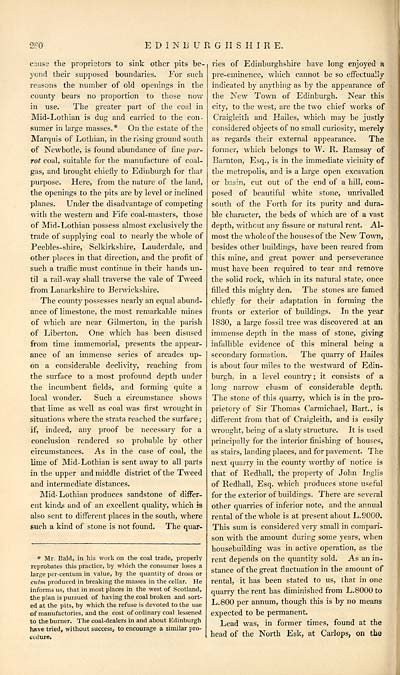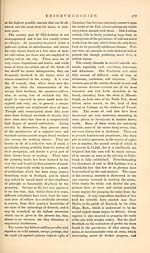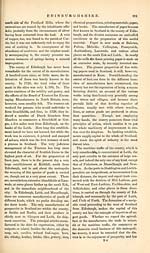Gazetteer of Scotland > Volume 1
(312) Page 280 - EDI
Download files
Complete book:
Individual page:
Thumbnail gallery: Grid view | List view

2?0
EDINBURGHSHIRE.
cause tlie proprietors to sink other pits be-
yond their supposed boundaries. For such
reasons the number of old openings in the
county bears no proportion to those now
in use. The greater part of the coal in
Mid-Lothian is dug and carried to the con-
sumer in large masses.* On the estate of the
Marquis of Lothian, in the rising ground south
of Newbotle, is found abundance of fine par-
rot coal, suitable for the manufacture of coal-
gas, and brought chiefly to Edinburgh for that
purpose. Here, from the nature of the land,
the openings to the pits are by level or inclined
planes. Under the disadvantage of competing
with the western and Fife coal-masters, those
of Mid- Lothian possess almost exclusively the
trade of supplying coal to nearly the whole of
Peebles-shire, Selkirkshire, Lauderdale, and
other places in that direction, and the profit of
such a traffic must continue in their hands un-
til a rail-way shall traverse the vale of Tweed
from Lanarkshire to Berwickshire.
The county possesses nearly an equal abund-
ance of limestone, the most remarkable mines
of which are near Gilmerton, in the parish
of Liberton. One which has been disused
from time immemorial, presents the appear-
ance of an immense series of arcades up-
on a considerable declivity, reaching from
the surface to a most profound depth under
the incumbent fields, and forming quite a
local wonder. Such a circumstance shows
that lime as well as coal was first wrought in
situations where the strata reached the surface ;
if, indeed, any proof be necessary for a
conclusion rendered so probable by other
circumstances. As in the case of coal, the
lime of Mid-Lothian is sent away to all parts
in the upper and middle district of the Tweed
and intermediate distances.
Mid- Lothian produces sandstone of differ-
ent kinds and of an excellent quality, which is
also sent to different places in the south, where
such a kind of stone is not found. The quar-
* Mr. Bald, in his work on the coal trade, properly
reprobates this practice, by which the consumer loses a
large per-centum in value, by the quantity of dross or
culm produced in breaking the masses in the cellar. He
informs us, that in most places in the west of Scotland,
the plan is pursued of having the coal broken and sort-
ed at the pits, by which the refuse is devoted to the use
of manufactories, and the cost of ordinary coal lessened
to the burner. The coal-dealers in and about Edinburgh
have tried, without success, to encourage a similar pro-
cedure.
ries of Edinburghshire have long enjoyed a
pre-eminence, which cannot be so effectually
indicated by anything as by the appearance of
the New Town of Edinburgh. Near this
city, to the west, are the two chief works of
Craigleith and Hailes, which may be justly
considered objects of no small curiosity, merely
as regards their external appearance. The
former, which belongs to W. R. Ramsay of
Barnton, Esq., is in the immediate vicinity of
the metropolis, and is a large open excavation
or basin, cut out of the end of a hill, com-
posed of beautiful white stone, unrivalled
south of the Forth for its purity and dura-
ble character, the beds of which are of a vast
depth, without any fissure or natural rent. Al-
most the whole of the houses of the New Town,
besides other buildings, have been reared from
this mine, and great power and perseverance
must have been required to tear and remove
the solid rock, which in its natural state, once
filled this mighty den. The stones are famed
chiefly for their adaptation in forming the
fronts or exterior of buildings. In the year
1 830, a large fossil tree was discovered at an
immense depth in the mass of stone, giving
infallible evidence of this mineral being a
secondary formation. The quarry of Hailes
is about four miles to the westward of Edin-
burgh, in a level country; it consists of a
long narrow chasm of considerable depth.
The stone of this quarry, which is in the pro-
prietory of Sir Thomas Carmichael, Bart., is
different from that of Craigleith, and is easily
wrought, being of a slaty structure. It is used
principally for the interior finishing of houses,
as stairs, landing places, and for pavement. The
next quarry in the county worthy of notice is
that of Redhall, the property of John Inglis
of Redhall, Esq. which produces stone useful
for the exterior of buildings. There are several
other quarries of inferior note, and the annual
rental of the whole is at present about L.G000.
This sum is considered very small in compari-
son with the amount during some years, when
housebuilding was in active operation, as the
rent depends on the quantity sold. As an in-
stance of the great fluctuation in the amount of
rental, it has been stated to us, that in one
quarry the rent has diminished from L.8000 to
L.800 per annum, though this is by no means
expected to be permanent.
Lead was, in former times, found at the
head of the North Esk, at Carlops, on the
EDINBURGHSHIRE.
cause tlie proprietors to sink other pits be-
yond their supposed boundaries. For such
reasons the number of old openings in the
county bears no proportion to those now
in use. The greater part of the coal in
Mid-Lothian is dug and carried to the con-
sumer in large masses.* On the estate of the
Marquis of Lothian, in the rising ground south
of Newbotle, is found abundance of fine par-
rot coal, suitable for the manufacture of coal-
gas, and brought chiefly to Edinburgh for that
purpose. Here, from the nature of the land,
the openings to the pits are by level or inclined
planes. Under the disadvantage of competing
with the western and Fife coal-masters, those
of Mid- Lothian possess almost exclusively the
trade of supplying coal to nearly the whole of
Peebles-shire, Selkirkshire, Lauderdale, and
other places in that direction, and the profit of
such a traffic must continue in their hands un-
til a rail-way shall traverse the vale of Tweed
from Lanarkshire to Berwickshire.
The county possesses nearly an equal abund-
ance of limestone, the most remarkable mines
of which are near Gilmerton, in the parish
of Liberton. One which has been disused
from time immemorial, presents the appear-
ance of an immense series of arcades up-
on a considerable declivity, reaching from
the surface to a most profound depth under
the incumbent fields, and forming quite a
local wonder. Such a circumstance shows
that lime as well as coal was first wrought in
situations where the strata reached the surface ;
if, indeed, any proof be necessary for a
conclusion rendered so probable by other
circumstances. As in the case of coal, the
lime of Mid-Lothian is sent away to all parts
in the upper and middle district of the Tweed
and intermediate distances.
Mid- Lothian produces sandstone of differ-
ent kinds and of an excellent quality, which is
also sent to different places in the south, where
such a kind of stone is not found. The quar-
* Mr. Bald, in his work on the coal trade, properly
reprobates this practice, by which the consumer loses a
large per-centum in value, by the quantity of dross or
culm produced in breaking the masses in the cellar. He
informs us, that in most places in the west of Scotland,
the plan is pursued of having the coal broken and sort-
ed at the pits, by which the refuse is devoted to the use
of manufactories, and the cost of ordinary coal lessened
to the burner. The coal-dealers in and about Edinburgh
have tried, without success, to encourage a similar pro-
cedure.
ries of Edinburghshire have long enjoyed a
pre-eminence, which cannot be so effectually
indicated by anything as by the appearance of
the New Town of Edinburgh. Near this
city, to the west, are the two chief works of
Craigleith and Hailes, which may be justly
considered objects of no small curiosity, merely
as regards their external appearance. The
former, which belongs to W. R. Ramsay of
Barnton, Esq., is in the immediate vicinity of
the metropolis, and is a large open excavation
or basin, cut out of the end of a hill, com-
posed of beautiful white stone, unrivalled
south of the Forth for its purity and dura-
ble character, the beds of which are of a vast
depth, without any fissure or natural rent. Al-
most the whole of the houses of the New Town,
besides other buildings, have been reared from
this mine, and great power and perseverance
must have been required to tear and remove
the solid rock, which in its natural state, once
filled this mighty den. The stones are famed
chiefly for their adaptation in forming the
fronts or exterior of buildings. In the year
1 830, a large fossil tree was discovered at an
immense depth in the mass of stone, giving
infallible evidence of this mineral being a
secondary formation. The quarry of Hailes
is about four miles to the westward of Edin-
burgh, in a level country; it consists of a
long narrow chasm of considerable depth.
The stone of this quarry, which is in the pro-
prietory of Sir Thomas Carmichael, Bart., is
different from that of Craigleith, and is easily
wrought, being of a slaty structure. It is used
principally for the interior finishing of houses,
as stairs, landing places, and for pavement. The
next quarry in the county worthy of notice is
that of Redhall, the property of John Inglis
of Redhall, Esq. which produces stone useful
for the exterior of buildings. There are several
other quarries of inferior note, and the annual
rental of the whole is at present about L.G000.
This sum is considered very small in compari-
son with the amount during some years, when
housebuilding was in active operation, as the
rent depends on the quantity sold. As an in-
stance of the great fluctuation in the amount of
rental, it has been stated to us, that in one
quarry the rent has diminished from L.8000 to
L.800 per annum, though this is by no means
expected to be permanent.
Lead was, in former times, found at the
head of the North Esk, at Carlops, on the
Set display mode to: Large image | Transcription
Images and transcriptions on this page, including medium image downloads, may be used under the Creative Commons Attribution 4.0 International Licence unless otherwise stated. ![]()
| Gazetteers of Scotland, 1803-1901 > Gazetteer of Scotland > Volume 1 > (312) Page 280 - EDI |
|---|
| Permanent URL | https://digital.nls.uk/97428106 |
|---|
| Description | Volume I: Abbey to Glenartney. |
|---|---|
| Attribution and copyright: |
|
| Description | By Robert Chambers and William Chambers. Glasgow: Blackie & Son, 1838. 2 volumes. |
|---|---|
| Shelfmark | NF.1461.g.7 |
| Additional NLS resources: | |

